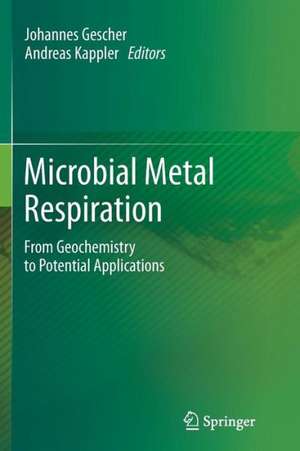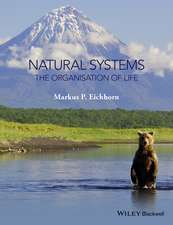Microbial Metal Respiration: From Geochemistry to Potential Applications
Editat de Johannes Gescher, Andreas Kappleren Limba Engleză Paperback – 13 dec 2014
| Toate formatele și edițiile | Preț | Express |
|---|---|---|
| Paperback (1) | 942.01 lei 6-8 săpt. | |
| Springer Berlin, Heidelberg – 13 dec 2014 | 942.01 lei 6-8 săpt. | |
| Hardback (1) | 788.00 lei 38-44 zile | |
| Springer Berlin, Heidelberg – 5 noi 2012 | 788.00 lei 38-44 zile |
Preț: 942.01 lei
Preț vechi: 1148.78 lei
-18% Nou
Puncte Express: 1413
Preț estimativ în valută:
180.25€ • 188.20$ • 149.18£
180.25€ • 188.20$ • 149.18£
Carte tipărită la comandă
Livrare economică 05-19 aprilie
Preluare comenzi: 021 569.72.76
Specificații
ISBN-13: 9783642441387
ISBN-10: 3642441386
Pagini: 244
Ilustrații: VIII, 236 p.
Dimensiuni: 155 x 235 x 13 mm
Greutate: 0.35 kg
Ediția:2012
Editura: Springer Berlin, Heidelberg
Colecția Springer
Locul publicării:Berlin, Heidelberg, Germany
ISBN-10: 3642441386
Pagini: 244
Ilustrații: VIII, 236 p.
Dimensiuni: 155 x 235 x 13 mm
Greutate: 0.35 kg
Ediția:2012
Editura: Springer Berlin, Heidelberg
Colecția Springer
Locul publicării:Berlin, Heidelberg, Germany
Public țintă
ResearchCuprins
Minerals and Aqueous Species of Iron and Manganese as Reactants and Products of Microbial Metal Respiration.- Energetic and Molecular Constraints on the Mechanism of Environmental Fe(III) Reduction by Geobacter.- Biochemistry of Extracellular Respiration in Shewanella oneidensis.- On the Role of Endogenous Electron Shuttles in Extracellular Electron Transfer.- Humic Substances and Extracellular Electron Transfer.- Metal Reducers und Reduction Targets. A Short Survey about the Distribution of Dissimilatory Metal Reducers and the Multitude of Terminal Electron Acceptors.- Metal Reduction as a Tool in Bioremediation Processes.- Dissimilatory Metal Reducers Producing Electricity.- Microbial Fuel Cells.
Textul de pe ultima copertă
Microbes can respire on metals. This seemingly simple finding is one of the major discoveries that were made in the field of microbiology in the last few decades. The importance of this observation is evident. Metals are highly abundant on our planet. Iron is even the most abundant element on Earth and the forth most abundant element in the Earth’s crust. Hence, in some environments iron, but also other metals or metalloids, are the dominant respiratory electron acceptors. Their reduction massively drives the carbon cycle in these environments and establishes redox cycles of the metallic electron acceptors themselves. These redox cycles are not only a driving force for other biotic reactions but are furthermore necessary for initiating a number of geochemically relevant abiotic redox conversions. Although widespread and ecologically influential, electron transfer onto metals like ferric iron or manganese is biochemically challenging. The challenge is to transfer respiratory electrons onto metals that occur in nature at neutral pH in the form of metal oxides or oxihydroxides that are effectively insoluble. Obviously, it is necessary that the microbes specially adapt in order to catalyze the electron transfer onto insoluble electron acceptors. The elucidation of these adaptations is an exciting ongoing process. To sum it up, dissimilatory metal reduction has wide-spread implications in the field of microbiology, biochemistry and geochemistry and its discovery was one of the major reasons to establish a novel scientific field called geomicrobiology. Recently, the discovery of potential applications of dissimilatory metal reducers in bioremediation or current production in a microbial fuel cell further increased the interest in studying microbial metal reduction.
Caracteristici
This book is a timely and comprehensive interdisciplinary review of our current understanding of respiratory metal reduction
Elucidates the different principles that have to be regarded to fully understand microbial metal reduction
Written by authors which belong to the forefront of researchers it is intended to be a resource - but not only - for geochemists, microbiologists, biochemists and environmental engineers
Includes supplementary material: sn.pub/extras
Includes supplementary material: sn.pub/extras
Elucidates the different principles that have to be regarded to fully understand microbial metal reduction
Written by authors which belong to the forefront of researchers it is intended to be a resource - but not only - for geochemists, microbiologists, biochemists and environmental engineers
Includes supplementary material: sn.pub/extras
Includes supplementary material: sn.pub/extras











